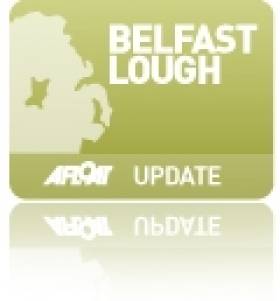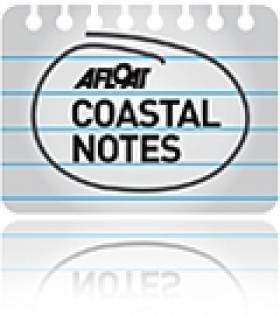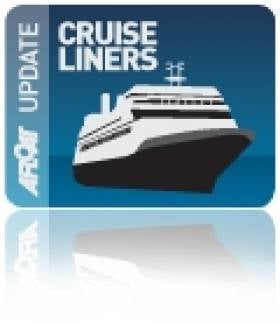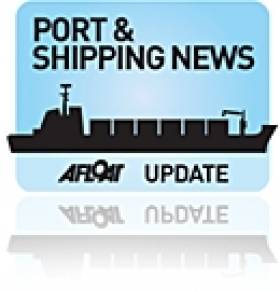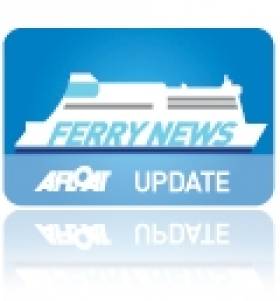Displaying items by tag: Belfast Harbour
Academic Arrangements at Sea
#CRUISE LINERS - New York based Academic Arrangements Abroad have chartered Zegraham Expeditions Clipper Odyssey which is to call to Belfast Harbour today for an overnight visit, writes Jehan Ashmore.
Academic Arrangements offer more than 50 countries for guests to go cruising and accompanied by renowned scholars on itineraries specific to the nation's visited with tours to pre-eminent museums and alumni associations.
The tours also take a look behind the scenes of major cultural institutions and privileged access to private art collections and impressive gardens.
Guests on-board the 110-passenger adventure-style ship, are accommodated in 64 outside cabins. They have a sitting area with sofa, flat-screen TV and an individually controlled thermostat. Larger sized cabins (beds arranged in twins or queen) are located on Bridge Deck and some have balconies.
Asides fine dining facilities, passengers can avail of amenities including an outdoor pool, gym and library. On the technology front, computers with internet access and Wi-Fi are provided in public areas.
As to be expected of the adventure-cruiseship, a fleet of boats (note Zodiacs on top deck) which allow passengers to access more isolated destinations and the ability to get closer to wildlife and nature.
During her Irish Sea cruising grounds this month, the vessel is scheduled to return to Belfast twice. To view other cruise callers click the LIST.
Ports & Shipping Review: Champagne Voyage, Cruiseship Safety, Scienceship, Ferry Sold, P&O 175th,Belfast Boost
#PORTS & SHIPPING REVIEW - Over the last fortnight Jehan Ashmore has reported from the shipping scene which saw the second WFSV Gardian 10 make a delivery 'Champagne 'promo-voyage to her UK East coast based owners.
Following the Costa Concordia incident, tighter inspections of vessels visiting our ports will be carried out according to the Marine Survey Office.
With all things scientific with the ESOF conference in Dublin, as part of Dublin City of Science 2012, there is still time to apply for the Marine Institute's training position for their research vessel operations.
The last ever passenger (incl. car-ferry) built by Harland & Wolff in 1981, the St. David for Sealink/British Rail departed on her long delivery voyage for new Indonesian owners. For most of her career she served as the Stena Caledonia on the North Channel routes until her recent sale and renaming to Portlink.
P&O Cruises Arcadia sailed into Dublin Bay following a spectacular gathering of her fleetmates in Solent waters to celebrate the 175th anniversary of the world famous shipping company. P&O can trace their origins with an Irish connection as the Dublin and London Steam Packet Co. chartered their paddle-steamer William Fawcett, the vessel being regarded as the first ship working for P&O.
Belfast Harbour revealed record traffic levels for the year 2010-2011 as outlined at the company's annual report. The port showed a 2% rise in profit before taxation to £17.8m and a 4% increase in turnover to £36.1m.
Also in the northern port, the new iconic waterfront landmark of the Belfast Titanic visitor attraction is a key contributory factor in drawing the cruiseship sector. A total of 41 cruise callers are scheduled in 2012 which is an increase to last year's 32 ships.
#BELFAST HARBOUR -The largest port in the north reported improved turnover and profit during 2010-2011, according to the annual report of Belfast Harbour.
The port showed a 2% rise in profit before taxation to £17.8m and a 4% increase in turnover to £36.1m. Underpinning the harbour's performance were record levels of tonnages handled during the period - up 7% to 17.6m tonnes. Although some sectors, such as those related to construction, continued to struggle, this was offset by growth elsewhere.
The number of freight vehicles passing through the port rose by 14% to 357,000 and a record four million tonnes were handled in the dry-bulk sector, which includes trades such as aggregates and coal.
Belfast Harbour noted that capital expenditure projects valued at £18.3m were completed during 2010-11. A further £53.8m was committed to additional projects at the year end, principally the development of the UK's first dedicated offshore wind logistics terminal for DONG Energy.
Len O'Hagan, Belfast Harbour's Chairman, said: "In spite of ongoing sluggishness in both the UK and Irish economies, Belfast Harbour has posted a very strong set of results for 2011, reflecting the diverse nature of the business and a long-term strategy of major capital investment to ensure that Belfast offers the most modern maritime facilities on the island.
"Significant uncertainty, however, still exists in the global economy, with the UK officially falling back into recession and the continuing eurozone crisis which is undermining business confidence throughout the continent and beyond.
"There are still opportunities for growth, though, particularly in renewable energy where Belfast Harbour is investing £50m in a new terminal for the assembly of offshore wind turbines. There have also been opportunities to further develop Belfast Harbour Estate, not least the Titanic Belfast visitor attraction, which received a £13.6m donation from Belfast Harbour, and the Northern Ireland Science Park which was the subject of a £6m investment by the Harbour to facilitate a 55,000 sq ft expansion."
During the year the port benefitted from several developments within the Irish Sea ferry sector, including the opening of Stena Line's new Scottish terminal at Loch Ryan Port (Cairnryan) and introduction of a pair of larger and more modern vessels. During this timeframe Stena Line had completed its takeover of DFDS Seaways Belfast - Birkenhead route and freight-only service to Heysham.
Mr O'Hagan added: "Although the overall performance of Belfast Harbour has been strong, it is clear that economic recovery across the UK and Ireland remains patchy. Belfast Harbour, however, is committed to its long-term strategy of investing in infrastructure to maintain the Port's competitiveness and provide much needed capital projects for the construction industry."
#dragon – After seven incredibly tough races over three days it all went down to a tie-breaker to decide the winner of the 2012 Dragon Northern Area Championship. Sponsored by Belfast Harbour and hosted by the Royal North Of Ireland Yacht Club on Belfast Lough from 30 June to 3 July, the event had attracted 32 competitors - the best entry in many years - including teams from Monaco and Australia as well as from across the UK and Ireland.
The quality of competition at the regatta was incredibly high with every mark rounding action packed and the difference between a podium place and mid fleet being just a matter of seconds in almost every race. The Race Committee was at the top of its game as they brought seven great races to the fleet despite some very shifty and variable conditions. Those seven races featured six different race winners and going into the final day the top four boats were separated by only five points.
As they went into the final race it was still anyone's regatta with Julia Bailey, crewed in Aimee by husband Graham, Dylan Potter and eleven year old Will Heritage holding a narrow lead on 19 points. A single point behind in second was Klaus Diederichs, sailing Fever with Andy Beadsworth and Jamie Lee. In third was Gavia Wilkinson-Cox, sailing Jerboa with Martin Payne and Rui Boia counting 23 points and in fourth was Chris Hunt, sailing Dark and Stormy with Mark Hart and Mark Daly, on 25 points. The overall points however were not fully known to the competitors as the class has a no VHF communication rule at its major championships and therefore did not know the identity of a single boat called over the start line (OCS) in the penultimate race. All four knew they had been close to the line and that no boat had returned across the line so almost any of them could be the disqualified boat.
With the wind constantly varying in both velocity and direction as rain showers rolled down across the hills from the south it was to be the toughest race of the series. For Diederichs and Bailey tricky starts were compounded by missed shifts and both boats scored their worst results of the regatta to put them out of the overall running. So it was down to Wilkinson-Cox and Hunt to fight it out for the laurels and what a fight it was with the two boats within yards of each other throughout the race. On the line Hunt just got the better of the situation finishing the race in second place with Wilkinson-Cox in fourth. Looking back down the fleet Wilkinson-Cox knew the points were tight but feared that her fourth place hadn't been sufficient and in fact was worried about whether she'd made the podium at all. It wasn't until she arrived back at the club house sometime later that she discovered that the OCS boat had been Simon Brien and that she had just snatched the 2012 Dragon Northern Area Championship on count-back from Hunt with Diederichs third and Bailey fourth.
At the prize giving dinner Gavia Wilkinson-Cox paid tribute to the regatta organisers led by Simon Brien, to her crew and to the quality of the competition saying. "Simon has already very eloquently thanked all those involved with running this event, but on behalf of everybody here I want to say the hugest thank to Simon. Nobody could have done more than he has to get everybody here. The other thank you of course goes to my crew Stavros and Rui - two fantastic sailors. And finally thank you all for being fantastic competitors and for the tough racing."
The Corinthian Trophy, for the first all amateur crew, went to Julia Bailey in Aimee, while Mark and Mandy Wade, sailing Avalanche with Simon Cash were Corinthian runners up and fifth overall. The Old Boat Trophy, for the top performance by one of the classic boats in the fleet, went to Sou'wester which was recently brought back to life after 16 years in storage by her crew of owner John Simms, John Gunning and Alan Morrison, who proved that there's plenty of life in the old girl yet by finishing 13th overall. Special mention must also go to Monaco's Jens Rathsack sailing Jeanie with Stefan Waak and Mario Wagner for being the only team to win two races in the regatta and who finished sixth overall.
Tomorrow the Edinburgh Cup - the Dragon British Open Championship - sponsored by Belfast Harbour gets underway and with the fleet growing to 46 teams with the addition of reigning World Champion and Olympic Bronze Medallist Lawrie Smith, reigning Edinburgh Cup Champion Martin Byrne, Double Olympic Gold Medallist and five time Edinburgh Cup Champion Poul Richard Hoj-Jensen and 2008 Edinburgh Cup Champion Don O'Donoghue, to name but a few, it will not only be the biggest Edinburgh Cup fleet in more than quarter of a century but also one of the toughest ever assembled.
The 2012 Edinburgh Cup sponsored by Belfast Harbour runs from Wednesday 4 to Saturday 7 July with up to six races scheduled. Racing will continue on Belfast Lough but the fleet will move seawards down the lough to allow for a much larger championship race course with beats of up to 2 miles. Once five races have been completed a single discard will be allowed.
#BELFAST BASIN CLOSURE – The Belfast Harbour website has a notice informing the temporary closure of the Abercorn Basin over this May Bank Holiday weekend.
The closure times of the basin are from 12.00pm on Sunday 6th May as this is to accommodate the 'Lough to Lagan Flotilla' event to be staged in the area. The facility will re-open as normal at 12.00pm on Monday 7th May.
Incidentally moored nearby on the far side of the Lagan opposite to the entrance of the Abercorn Basin, lies the 87m general dry-cargo ship Union Moon. As previously reported the Cook Island flagged vessel was in a collision with a ferry in Belfast Lough in early March.
Cruiseship Call to Remember Belfast's Titanic
#TITANIC- In this centenary year of the R.M.S.Titantic's sinking, Fred Olsen Cruise Lines Balmoral is to include a port of call to Belfast Harbour, where passengers are to visit the Harland & Wolff shipyard, during an Easter mini cruise in early April, writes Jehan Ashmore.
Balmoral will be the first cruiseship to berth in Belfast this year and her passengers are to visit the world famous shipyard on Queens Island where the liner was built for the White Star Line.
In addition there will be opportunities to call to the Botanical Gardens, Ulster Museum and Belfast Castle. The three-night mini-cruise starts in Southampton and is to include an en-route call to Liverpool, a former City of Culture.
For further information on other cruise calls to Belfast as previously reported on Afloat.ie click this HERE. In addition to the Titanic Walking Festival (31 March-22 April) as also reported click HERE
Cruiseship Boost for Belfast
#CRUISE LINERS-Belfast Harbour looks forward to another bumper year as cruise operators are to increase by 32% compared to last year, with 41 cruise ships bringing almost 75,000 visitors to the port.
The following major operators are to visit: Cruise & Maritime Voyages, Fred Olsen Cruise Lines, Holland America Line, Princess Cruises and Saga Cruise and others will dock from far flung destinations.
At over 1km long, Stormont Wharf, will again be the main berth for cruiseships in particular the ability to accommodate an increasing trend in larger class vessels touring the Irish Sea. The wharf was extended in recent years at a cost of £10m and is the longest deepwater quay in Ireland.
To promote Belfast Harbour as a cruiseship destination, the port and the Belfast Visitor and Convention Bureau (BVCB) set up the Cruise Belfast Initiative to market the location internationally.
For further information visit www.cruise-belfast.co.uk and to view the seasons schedule of cruise callers click HERE.
Record Tonnage for Belfast Harbour
#PORTS & SHIPPING – Figures released by Belfast Harbour for the year 2011 show that tonnage rose by 7% to a record 17.644m tonnes. The increase for last year was driven by strong performances in break-bulk and ro-ro (freight vehicles) and in the dry-bulk sector.
Break-bulk products jumped 23% to 332,000 tonnes. In particular, steel and steel coil traffic doubled in 2011 compared with 2010 reflecting improved activity in Northern Ireland's engineering manufacturing sector, while the number of freight vehicles using the port rose by 14%.
Dry-bulk, which includes items such as aggregates and agri-food related products, exceeded four million tonnes for the first time in the port's history.
There was a record year for stone exports, up 13% to one million tonnes, reflecting on-going road maintenance and construction projects in the UK and Europe.
Other notable performers in the sector included scrap metal (up 8%) and salt (up 82%), driven by last winter's 'Big Freeze' and according to the port, they expect similar conditions this year.
Irish Sea Cross Channel Fast-Ferry Services On Declining Trend
The third service between Belfast-Stranraer is in the hands of rivals Stena Line which maintain the HSS Stena Voyager (1996/19,638 grt) on sailings but only to around mid-November. She will be replaced by conventional sister-ships which will be introduced on the North Channel's newest port when services switch from Stranraer to a new terminal close to Cairnryan.
Finally the fourth fast-ferry is Irish Ferries marketed 'Dublin Swift' service which runs on the Dublin-Holyhead route served by Jonathan Swift (1999/5,989 grt). The craft built by Austal in Fremantle, operates alongside the conventional cruise-ferry Ulysses.
Stena Line's decision to terminate HSS Stena Explorer sailings between Dun Laoghaire-Holyhead this day last week follows fast-ferry Stena Lynx III's end-of-season Rosslare-Fishguard sailings earlier this month.
From next year, Dun Laoghaire-Holyhead sailings are to be seasonal-only and according to Stena Line they hope to resume fast-ferry sailings in April or May though no exact date has been set. Unlike the central corridor route which was entirely dependent on HSS operations, the Rosslare-Fishguard route remains operating year-round with the conventional ferry Stena Europe.
As a result of the discontinued fast-ferries, the HSS Stena Explorer is now spending a lay-up period in the Welsh port for the winter. The smaller Stena Lynx III is also 'wintering' but in on the opposite side of the Irish Sea in Dun Laoghaire, where the vessel has done so in previous years.
The lay-up of both fast-ferries in Dun Laoghaire and Holyhead is ironic considering that neither ports' are connected by the very craft that used to share sailing rosters in recent years. In addition the wintering of these catamaran craft is the first time that this has occurred since the pioneering Stena Sea Lynx fast-ferry launched such sailings in 1993.
This first 'Lynx' provided seasonal sailings on the route with conventional car-ferry Stena Hibernia, the former St. Columba, custom-built in 1977 for Sealink /British Rail. She was given a second name under Stena ownership, the Stena Adventurer and remained on the 57 nautical-mile route until replaced in 1996 by the year-round operated HSS Stena Explorer.
Apart from cross-channel fast-ferry services, the Isle of Man is served by the Isle of Man Steam Packet Co. Ltd's routes linking the islands capital Douglas with Belfast, Dublin, Heysham and Liverpool (Birkenhead) in the winter. These routes include seasonal services which are operated by a combination of conventional tonnage using Ben-My-Chree and fast-ferry Manannan (1998/5,089grt), a former US Navy vessel, to read more click HERE. For sailing schedules, vessel type deployed on route and for fares click HERE.
- Dublin Port
- Irish Ferries
- Dun Laoghaire
- Stena Europe
- Holyhead
- P&O Ferries
- Belfast Harbour
- Stena Line
- Larne
- Ports and Shipping News
- Ulysses
- P&O (Irish Sea)
- Cairnryan
- Ferry news
- Stena Explorer
- Stena Express
- FastFerries
- Cruiseferry
- Manannan
- Isle of Man Steam Packet Co.
- Stena Voyager
- Belast Port
- Isle of Man ferry services
- P&O Express
- Irish Sea fastferries
- Stena 'Lynx'
- BenMyChree
- Dublin Swift
- Stena Sea Lynx
Sponsorships of Ice-Sea Giants
Stena Line themselves will be looking forward to introducing their own giants when two of the largest ferries are to be introduced on the North Channel in the Autumn. The two chartered 30,000grt sisterships are Superfast VII and Superfast VIII. To see the vessel breaking through an an ice-flow, click PHOTO. The 203m long pair can take 1,200 passengers, around 660 cars or 110 freight vehicles. To read more about these 'Superfast' class vessels and the new £80 port terminal click HERE.
The company's area director Michael McGrath said: "It's quite fitting that we are teaming up with the Stena Line Belfast Giants at this time as we prepare to introduce two of the largest ferries every to sail between Northern Ireland and Scotland when we open our new route and port in Cairnryan this November. The two Superfast vessels will be another two Giants to add to our team."
Last year Stena Line made a £40m acquisition of the Belfast to Liverpool (Birkenhead) and Heysham routes and four vessels from DFDS Seaways. The deal was approved by the Irish authorities but remained subject to clearance from the UK's Competition Commission until late last month when they fully approved the acquisition.
This brings to six routes the company runs on its Irish Sea route network where over two million passengers were carried each year, more than its rival ferry operators combined.
- DFDS Seaways
- Belfast Harbour
- Stena Line
- North Channel
- Competition Commission
- BelfastHeysham
- Superfast VII
- Superfast VIII
- Belfast Lough News
- Belfast Port
- Odyssey Arena
- Belfast Giants
- BelfastCairnryan
- New ferryport
- Nottingham Panthers
- Sheffield Steelers
- Hockey Festival Weekend
- BelfastLiverpool (Birkenhead)
- Irish Sea ferry companies
- Irish icehockey





























